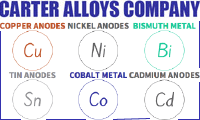
-----
Tin plating for very cold environments; alloying to avoid tin pest
2003
I am wanting some parts tin plated. The environment is part of an installation on mountain tops, with temperatures real cold, (possibly below -30 °C and worst case for tin pest). My understanding is that the plating should contain traces of Antimony, Bismuth and Lead up to about 1% total, in order to avoid tin pest. The plating companies I have contacted advise that they plate pure tin, and there are never any troubles. I have a sample assay which shows 99.9% pure, with traces of the above at a level of about 0.02% each.
The parts are spacers, about 75 mm diameter, and 5 mm thick. The question is, do I have a problem. Will standard plating fail, or is the advise I have received indeed correct and I am worrying for nothing.
Cheers,
Hardware Engineer - Wellington, Wellington, New Zealand
You are quite correct that pure tin would be troublesome at ů30 C; see letters #740 and
#18849.
Refer your platers to Appendix X6.2.2 of ASTM B545: "Where electroplated tin coatings are subject to long-term storage or use at very low temperatures, it may be advisable, when specified by the purchaser, to codeposit small amounts (<1%) of bismuth, antimony, or lead with the tin. These alloying additions, particularly the first, have been shown to inhibit the transformation." According to
ASM Handbook vol. 5 Surface Engineering, Federal spec. QQ-S-571 recommends 0.27% antimony although it seems that tin-bismuth plating solutions using methane sulfonic acid (MSA) are more readily available.
- Goleta, California
Rest in peace, Ken. Thank you for your hard work which the finishing world, and we at finishing.com, continue to benefit from.
2003
adv.: Supplier of Copper Anodes, Nickel Anodes, Bismuth Metal, & Other Metal Products for Industry & The Arts

Q, A, or Comment on THIS thread -or- Start a NEW Thread